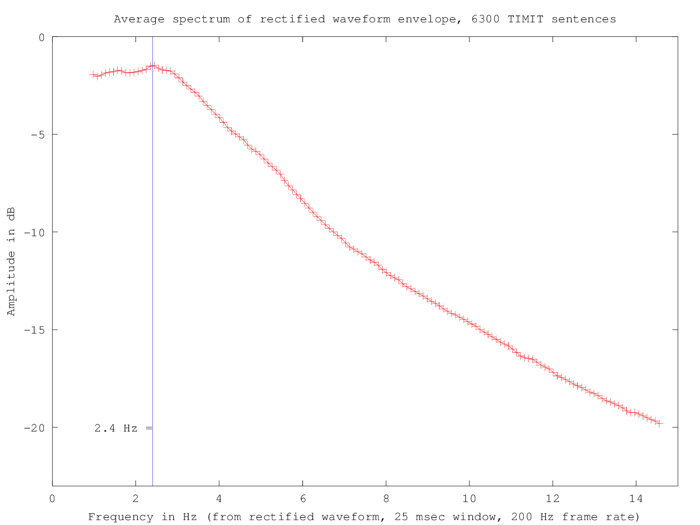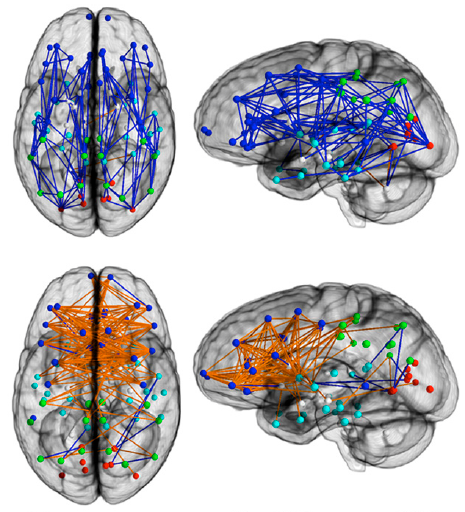Can you tell the difference between English and Chinese?
… from the pitch contours alone? It should be easy, right? Chinese is a tone language, English isn't, etc.
So try it…
Read the rest of this entry »
… from the pitch contours alone? It should be easy, right? Chinese is a tone language, English isn't, etc.
So try it…
Read the rest of this entry »
Exceedingly few people (almost none) can write the Chinese characters for the Mandarin word for "sneeze" (dǎ pēntì). I suspect that most people would also get one or both of the characters for "cough" (késou) wrong, though it's not as hard as dǎ pēntì.
I mentioned this surmise to several colleagues and encouraged them to test themselves, their friends, and their students to see whether they could write késou correctly, or even at all. I cautioned them that it should not be permitted to use any electronic device or reference material (dictionaries, etc.) to remind those being tested how to write the two characters for késou. They must simply be written out directly on paper by hand.
Read the rest of this entry »
Because Language Log readers are already familiar with this "most useful word in the Japanese language", and because of its highly polysemantic and multifunctional quality (see the very nerdy, thorough, and entertaining discussion of the various meanings and applications of "sumimasen" on Tofugu, "Sorry for Saying Thank You: The Many Uses Of Sumimasen"), I have decided to leave it untranslated, even in the title of this post. The purpose of the present piece is to further explore the subtleties, nuances, and history of "sumimasen", in hopes not only that this exceptional Japanese word will be better appreciated, but that it will be used more appropriately by those of us who were not born to it.
Read the rest of this entry »
Paul Krugman, "The Facebooking of Economics", 12/17/2013:
Economics journals stopped being a way to communicate ideas at least 25 years ago, replaced by working papers; publication was more about certification for the purposes of tenure than anything else. Partly this was because of the long lags — by the time my most successful (though by no means best) academic paper was actually published, in 1991, there were around 150 derivative papers that I knew of, and the target zone literature was running into diminishing returns. Partly, also, it was because in some fields rigid ideologies blocked new ideas. Don’t take my word for it: It was Ken Rogoff, not me, who wrote about the impossibility of publishing realistic macro in the face of “new neoclassical repression.”
Read the rest of this entry »
 In "Speech rhythms and brain rhythms", 12/2/2013, I showed the results of a simple experiment looking for evidence of speech rhythms in the frequency domain, which found a peak at about 2.4 Hz in the average spectrum of the waveform envelope of 6300 read sentences. I don't have anything new to say about what what this means, but I wanted to note a 65-year-old example of a somewhat similar experiment.
In "Speech rhythms and brain rhythms", 12/2/2013, I showed the results of a simple experiment looking for evidence of speech rhythms in the frequency domain, which found a peak at about 2.4 Hz in the average spectrum of the waveform envelope of 6300 read sentences. I don't have anything new to say about what what this means, but I wanted to note a 65-year-old example of a somewhat similar experiment.
Read the rest of this entry »
Such a proposition is preposterous on the very face of it. Yet a commenter to this blog has repeatedly made this claim in all earnestness, and even attempted to back up his claim with various types of evidence. I asked some friends and colleagues what they thought of such an assertion, and many of the more temperate responses I received have been included in the comments to "No character for the most frequent morpheme in Taiwanese", where the comparison was made; see also the earlier "Spoken Hong Kong Cantonese and written Cantonese", where the same commenter made the identical claim.
Read the rest of this entry »
For those wondering why on earth an official announcement about the solemn business of executing a traitor would use wildly overheated language like "despicable human scum" and "worse than a dog" (especially about the uncle of the reigning monarch), the BBC has published a short article on the language of North Korean posthumous character assassination.
Read the rest of this entry »
Permalink Comments off
Henry Hitchings has an op-ed in the New York Times (12/13/2013), "A Poor Apology for a Word", in which he claims that the British (and especially the English) are particularly fond of the word "sorry":
…A couple of years ago, I read an article in a British newspaper claiming that the average British person says “sorry” eight times a day — or “204,536 times in threescore years and ten,” in the reporter’s Old Testament idiom. My first reaction was to think this figure absurdly high, so I decided to put the claim to the test.
This initially tentative exercise turned into a monthlong audit of apologies. As soon as I began recording instances of the word in my day-to-day life, I realized that the eight-a-day number was a piddling lowball.
Read the rest of this entry »
Some useful framing for the Ingalhalikar et al. paper I wrote about earlier today — Christian Jarrett, "Getting in a Tangle Over Men's and Women's Brain Wiring", Wired 12/4/2013:
[L]et’s set this new brain wiring study in the context of previous research. Verma and her team admit that a previous paper looking at the brain wiring of 439 participants failed to find significant differences between the sexes. What about studies on the corpus callosum – the thick bundle of fibres that connects the two brain hemispheres? If women really have more cross-talk across the brain, this is one place where you’d definitely expect them to have more connectivity. And yet a 2012 diffusion tensor paper found “a stronger inter-hemispheric connectivity between the frontal lobes in males than females”. Hmm. Another paper from 2006 found little difference in thickness of the callosum according to sex. Finally a meta-analysis from 2009: “The alleged sex-related corpus callosum size difference is a myth,” it says.
OK, one last thing. I don’t know if you saw it, but earlier this year another study involving hundreds of participants used a different technique (resting state fMRI) to examine connectivity in the brain, this time for the purpose of seeing if some people have more left-brain functional hubs and others have more right-brained hubs (they don’t). This obviously isn’t the same focus as the new PNAS paper, but if men and women’s brains really are wired up differently to optimise them for map reading or multitasking etc, you’d think there’d be some important sex differences in the way functional hubs are lateralised (distributed to one side of the brain or the other). In fact, “no differences in gender were observed,” the authors said.
In conclusion – Wow, those are some pretty wiring diagrams! Oh … shame about the way they interpreted them.
Read the rest of this entry »
 The paper that Geoff referred to a bit earlier today is Madhura Ingalhalikar et al., "Sex differences in the structural connectome of the human brain", PNAS 2013. It features a very impressive graphic showing sex differences in connectivity of regions within the brain, indicating a pattern where males (top row in the figure) "had greater within-hemispheric connectivity, as well as enhanced modularity and transitivity", whereas "between-hemispheric connectivity and cross-module participation predominated in females" (bottom row in the figure). This is argued to suggest that "male brains are structured to facilitate connectivity between perception and coordinated action, whereas female brains are designed to facilitate communication between analytical and intuitive processing modes".
The paper that Geoff referred to a bit earlier today is Madhura Ingalhalikar et al., "Sex differences in the structural connectome of the human brain", PNAS 2013. It features a very impressive graphic showing sex differences in connectivity of regions within the brain, indicating a pattern where males (top row in the figure) "had greater within-hemispheric connectivity, as well as enhanced modularity and transitivity", whereas "between-hemispheric connectivity and cross-module participation predominated in females" (bottom row in the figure). This is argued to suggest that "male brains are structured to facilitate connectivity between perception and coordinated action, whereas female brains are designed to facilitate communication between analytical and intuitive processing modes".
Geoff linked to a letter from Rae Langton and John Dupré, which argues that "if the mind is the brain, any mental difference will be a brain difference", and that "training up half of humanity one way, half another" will inevitably create mental differences, which will correspond to brain differences, so that it's a mistake to see these results as necessarily a "deterministic fairy tale" about evolutionary biology, rather than a consequence of contemporary cultural differences.
This is all true, but I wonder whether something even simpler might be going on.
Read the rest of this entry »
The little village of Qunu in the Eastern Cape province of South Africa, birthplace and final resting place of Nelson Rolihlahla Mandela, is in the news today. But I have heard no one on the BBC's radio services who can even attempt to pronounce the name correctly. The IPA transcription is ['k!u:nu]. That initial consonant does not sound like [k] as in a word like kudu (the [k] in the transcription merely signifies that the consonant transcribed [!] is voiceless). It is a click consonant, produced by creating a suction effect above the tongue in the roof of the mouth and then pulling the tongue tip away from the ridge behind the upper front teeth so that air rushes in to make a dull "pop" like the sound of a champagne cork coming out. The lips are rounded to amplify the lower frequencies of the resultant click. It is not at all difficult to do: most people can imitate the popping of a champagne cork with their tongue. Putting it into a syllable like [k!u:] is not quite so easy. And after quite a bit of listening to BBC reporters and newscasters during this week of farewell for the great Nelson Mandela, I have heard no one even attempt it.
Read the rest of this entry »
Permalink Comments off
People have been asking Language Log (well, at least one somewhat off-topic commenter asked once) whether we have a view about the recent study alleging sex differences in brain wiring by Ragini Verma and colleagues. Language Log does not really regard this as a linguistic story, but keeps an eye on such neurophysiological topics for their occasional implications for language and the way it is implemented in the brain, and also on the language in which such science is reported. The study has been (of course) wildly overhyped, with newpaper stories around the world talking about men's and women's brains being wired completely differently (guys, you have tons of front-back wiring to aid you in spear-chucking and direction-finding; gals, you have oodles of left-right cross-connections to aid you in gossiping and domestic multi-tasking; that sort of thing). For a short, sharp, and well-informed critique of the way ideology (and philosophical error) warps the press interpretation of brain-scan results, take a look at the letter by Rae Langton and John Dupré in the Guardian, submitted by two excellent British philosophers with interests in both the biology and ideology of the relations between the sexes. They call the press coverage of this study a "deterministic fairy-tale" that is "bad for men and women, bad for science, bad for us all."
Update: A fuller version of the Langton/Dupré letter with discussion can be found on Brian Leiter's blog, and there is more here on Language Log here and here.
Permalink Comments off